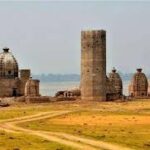Bathu Ki Ladi Temples are three kilometres from Dhameta, a small town in Kangra. There stands a cluster of antique, unique, tall temples that remain dipped in water for most of the time in a year. Finally, temples are exposed during the months of March to June. A lot of pilgrims visit these temples during this time. Throughout the year, this place, commonly known as ‘Bathu ki Larhi’ (a string of Bathu stone structures) enjoys the unique distinction of being a popular tourist spot.
Bathu Ki Ladi Temple is indeed dedicated to Lord Shiva. It is a significant temple located in Himachal Pradesh, India, specifically in the village of Bathu, near Jawali in Kangra district.
This temple is unique because it is surrounded by water during the monsoon season when the Maharana Pratap Sagar Lake (Pong Dam Reservoir) fills up. This gives the illusion that the temple is floating on water.
The Bathu Ki Ladi Temple is revered by locals and visitors alike. Its scenic location and the special atmosphere created by the water surrounding it make it a popular spot for both religious worship and tourism. It’s especially picturesque during the monsoon season when the temple seems to rise from the midst of the reservoir.
Bathu ki Larhi is a cluster of eight temples covering a vast area that used to have strong protection walls which are now falling and crumbling in the strong current of water.
Even though for the last 30 years, this cluster of temples remains dipped in the water for eight months every year their stone structure has the same natural color, beauty, and luster as it used to have when they were actually constructed. Such is the durability of Bathu stone, a quality preferred in the entire Himachal. Only the color of the plaster and those of the bricks have undergone a change. The stone images are set on both sides of this gate, one image being of Mother Kali and the other of Lord Ganesha. Before one enters the temple complex, one has to pass through another main gate, of which indicates how this cluster of temples was covered with two protection walls to save them from foreign invaders, There are also protection walls and protection. Towers, now in crumpled shape, show how those days’ defense system was par excellence…

